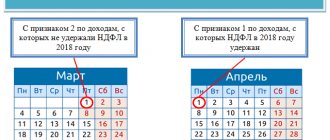General approach
From January 1, 2021, the Law of August 3, 2018 No. 303-FZ (hereinafter referred to as Law No. 303-FZ) with amendments to the Tax Code of the Russian Federation is in force. He demanded a kind of transition period for VAT from 18 to 20% in relation to goods (work, services), property rights specified in paragraph 3 of Art. 164 Tax Code of the Russian Federation.
The Federal Tax Service proceeds from the fact that:
- a 20% rate applies to goods (work, services), property rights shipped (performed, rendered) transferred starting from January 1, 2021 (clause 4 of article 5 of Law No. 303-FZ);
- does not provide for exceptions for contracts concluded before the entry into force of Law No. 303-FZ and having a continuing nature with the transition to 2021 and subsequent years .
Consequently, with regard to sales, etc., the VAT rate of 20% applies regardless of the date and conditions of the conclusion of contracts.
At the same time, on the basis of paragraph 1 of Art. 168 of the Tax Code of the Russian Federation, in addition to the shipping price, starting from 01/01/2019, the seller is obliged to present to the buyer for payment the amount of tax calculated at a rate of 20 percent.
In this regard, there is no need to make changes to the agreement regarding changes in the VAT rate. Although its parties may clarify the calculation procedure and the cost of sales in connection with an increase in the VAT rate.
Also see “Additional agreement to the agreement on changing the VAT rate from 2021: sample”.
An increase in the VAT rate does not change the procedure and time for determining the tax base for VAT for the payer.
How will the shipment proceed against the advances that were received earlier, taking into account the change in rate?
Let's give a specific example.
Example 1. Let the seller in 2021 receive from the buyer an advance amount for goods supplied in the amount of 100%. The goods are planned to be released to the client in the first month of 2021. In the previous period, the VAT rate was 18%, which means that the seller will calculate tax at the rate of 18/118 from the prepayment amount (clause 4 of Article 164 of the Tax Code of the Russian Federation).
On the date of product release, the seller deducts the amounts of tax that were previously calculated by him from the amount of prepaid amounts (clause 8 of Article 171, clause 6 of Article 172 of the Tax Code of the Russian Federation). That is, in this example, in a situation where goods will be shipped in 2021 on account of the prepaid amount, the seller accepts a rate of 18/118 for deduction. In such a situation, for goods that have been shipped, he will invoice the amount including VAT at a rate of 20%. It is at this rate that he must pay tax to the budget. But since the seller previously received only 18% for the product, he pays the difference of 2% out of his own pocket.
It should be taken into account that if no separate conditions were previously specified in the contract, then he will not be able to shift this obligation to pay an additional 2% to the buyer. For the seller, the best option would be to conclude an additional agreement in advance at the end of 2021, indicating at the moment information about an increase in the VAT rate to 20% and an additional payment of 2% in excess of advance payments.
A sample additional agreement with the buyer is presented in the appendix to the work.
Next, let's go deeper with an example. Let us assume that such an agreement was concluded between the parties. The question arises: at what point in the transition period should the additional payment be made: in 2021 or 2021?
There is clarification on this question from the tax service.
If the VAT surcharge is made during the transition period in 2021, it will not be considered as a tax surcharge. This amount will be counted as an increase in the cost of the goods. In such a situation, you will have to pay VAT on this amount in 2021 at a rate of 18/118. The seller will have to issue an invoice with the adjustment to the buyer.
M.Yu. Lermontov, tax service advisor, 2nd rank
Example 2. Let’s assume that I received an advance from the buyer in the amount of 118 tr. (100% prepayment) and issued an invoice. The date of receipt of the advance is November 20, 2021.
Shipment is planned for 2021.
Additional payment of VAT in the amount of 2 tr. received from client 12/25/2021.
The seller issues a corrective invoice for the amount of the advance that was received in November 2021.
A sample of such an invoice is presented in the table below.
| Indicators | Tax rate, % | Tax amount. t.r. | Cost of goods, t.r. |
| Before the changes | 18/118 | 18 | 118 |
| After the change | 18/118 | 18,305 | 120 |
| Upward adjustment | – | 0,305 | 2 |
In the process of releasing products in 2021, VAT on account of prepayment will be determined at a rate of 20% in the amount of 20,339 tr. ((120-18,305)* 20%). VAT will be deducted from the advance payment in the amount of 18,305 tr. That is, the difference is 2,034 tr. must be paid to the budget from the supplier’s own pocket.
We can conclude that creating an invoice in the form of an adjustment does not solve the problem of additional payment of 2% VAT to the budget for the seller.
Change from 01/01/2019 in the cost of goods shipped before 01/01/2019
Due to the increase in VAT during the transition period of 2021 and 2021, there is a high probability of changes in their prices. Here are the steps to take in this case.
If goods (work, services), property rights were shipped (transferred) before 01/01/2019, then if their value changes upward or downward from 01/01/2019, the tax rate in effect on the date of shipment (transfer) is applied.
In this regard, in column 7 of the adjustment invoice, the VAT rate that was indicated in column 7 of the invoice for which the adjustment document was drawn up is given.
Electronic services
Today, companies that provide electronic services in Russia pay VAT only when the buyers are ordinary citizens (Clause 2 of Article 174.2 of the Tax Code of the Russian Federation). The tax may be determined by the foreign company to be at a rate of 15.25%. If services are provided to organizations or individual entrepreneurs, then they, as tax agents, pay VAT amounts for the foreign company.
From January 1, 2021, the conditions change, since the foreign company itself will have to pay VAT in any case at a rate of 16.67%.
If payment for services was received in 2021, then taxation will be carried out as follows:
- when providing services in 2021, VAT rate: 15.25%;
- when providing services in 2021, the rate remains 16.67%.
Correction of invoice for goods shipped before 01/01/2019
In the new copy of the invoice:
- you cannot change the indicators (numbers and dates) indicated in line 1 of the invoice compiled before the corrections were made to it;
- fill out line 1a, where they indicate the serial number of the correction and the date of the correction.
In this regard, when making corrections to an invoice issued for shipment before 01/01/2019, in column 7 of the amended document indicate the rate in effect on the date of shipment and reflected in column 7 of the invoice issued for the shipment of these goods.
Who is exempt from paying VAT
- Organizations under special taxation regimes: USNO, UTII, Unified Agricultural Tax;
- IP on PSNO, USNO, UTII and Unified Agricultural Tax;
- Organizations and individual entrepreneurs whose revenue for the last 3 months did not exceed 2 million rubles;
- Participants of the Skolkovo project.
Please note that VAT exemption is not provided for individual entrepreneurs and organizations selling excisable goods, importing products into the territory of the Russian Federation, as well as in the case of issuing an invoice with an allocated VAT amount.
Return of goods from 01/01/2019
VAT from the seller
When returning from 01/01/2019 the entire batch (or part) of goods - both accepted and not accepted for registration by buyers - the Federal Tax Service recommends that the seller issue adjustment invoices for the cost of goods returned by the buyer, regardless of the period of shipment of the goods. That is, until 01/01/2019 or from the specified date.
If in column 7 of the invoice to which the adjustment invoice was drawn up, a tax rate of 18% is indicated, then in column 7 of the adjustment invoice a rate of 18% is also given.
And here is what the seller should do when returning from 01/01/2019 goods paid for by persons who are not VAT payers and/or payers exempt from fulfilling taxpayer obligations related to the calculation and payment of tax, for whom invoices are not issued, and shipped (transferred ) to these persons until 01/01/2019. An adjustment document is recorded in the purchase book with summary (summary) data on return transactions made during the calendar month (quarter), regardless of the readings of the cash register equipment.
Also see "VAT during the transition period 2021 and 2021: what to do as a seller."
VAT from the buyer
If the buyer has accepted for deduction the amounts of tax presented to him for the goods he accepted for registration, then he restores the VAT amounts on the basis of an adjustment invoice from the seller (subclause 4 of clause 3 of Article 170 of the Tax Code of the Russian Federation) regardless of the period of shipment of the goods. That is, until 01/01/2019 or from the specified date.
Read also
30.10.2018
Transition situation when additional VAT payment is carried out in 2021
Another situation is when an additional payment of 2% is made by the buyer after January 1, 2021. In such a situation, the payment is accepted precisely as an additional payment of VAT, it does not go towards the prepayment for goods (where it will be necessary to pay VAT at a rate of 20/120). In such a situation, the seller issues an invoice for the adjustment for the buyer for the difference between the tax amount on the invoice -invoice, which was drawn up earlier at the rate of 18/118, and tax calculated taking into account the surcharge.
Example 3 . Let’s take the same enterprise, Romashka LLC. The only difference is that the buyer paid the additional amount in January 2021.
The additional payment has been received by the seller. The latter draws up the adjustment invoice, which is presented in the table below.
| Indicators | Tax rate, % | Tax amount. t.r. | Cost of goods, t.r. |
| Before the changes | 18/118 | 18 | 118 |
| After the change | 20/120 | 20 | 120 |
| Upward adjustment | – | 2 | 2 |
When releasing products in 2021, on account of the advance amount received, the seller determines VAT at a rate of 20% of the amount of sales of goods (100 tr.) in the amount of 20 tr. and will deduct VAT 20 tr.
Important! If the additional payment amount is made by buyers who are not VAT payers, then in such a situation the reflection of the amount of additional tax payment in the sales book will be made by the seller on the basis of an adjustment document that contains summary data on all situations of additional tax payment.
Example 4 Let's look at another example. The seller receives prepayment amounts against future shipments. Advances were paid on the following dates:
- LLC "Phoenix" - 11.8 tr. (including VAT – 1.8 tr.);
- LLC "Smart" - 7,080 tr. (including VAT – 1,080 tr.).
Both of these organizations do not pay VAT. They are not issued invoices
In January 2021, buyers fulfilled the additional payment amount of 2% VAT:
- LLC "Phoenix" - 0.2 tr. ((11.8 – 1.8)*0.2);
- Smart LLC – 0.12 tr. ((7.080-1.080) * 0.2).
On January 31, 2021, the seller's adjustment document looks like this.
| Buyer | Amount for additional VAT payments, t.r. |
| Phoenix LLC | 0,2 |
| LLC "Smart" | 0,12 |
| TOTAL | 0,32 |
The following entries were made in the sales book:
- Column 5 indicates the number and date of the adjustment document (No. 1 dated 01/31/2021);
- Column 13 indicates the difference in the cost of sales including VAT (0.32 tr);
- in column 17 - the amount of additional tax payment (0.32 tr.)
Important! In a situation where settlements with buyers who do not pay VAT are made using a cash register, the reflection of the amounts in the sales book, adjusted in the documents for additional payment of tax, is carried out regardless of the readings of the cash register. This means that there is no need to register cash register receipts that are punched when receiving additional payments as a prepayment amount.
VAT reporting
The VAT return is submitted based on the results of each quarter no later than the 25th day of the following month.
Note: starting from 2014, VAT returns are submitted only in electronic form. Submitting reports on paper while being required to submit them electronically will be equated by the tax authority to failure to submit a return at all.
In addition to the tax return, VAT payers are required to maintain tax accounting registers: books of purchases and sales.




